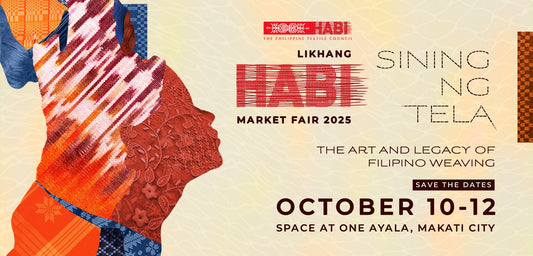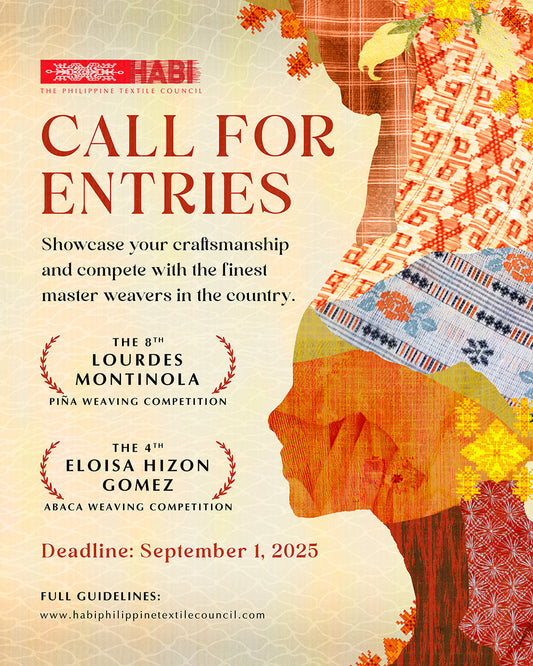Author: “Gayle” Zialcita for HABI: The Philippine Textile Council

Ikat is a method of preparing thread before being hand woven on a loom, to create an Ikat Textile. The key to ikat is to create the design by tying areas of thread in bunches. These tied areas called, “binding,” covers the exposed thread, which will resist the dye when the bundle of prepared thread becomes soaked into a dyebath. The binding material choices are rope, coconut coir, abaca, string or similar material.

The Seventh World Ikat Symposium (WITS), in Baguio City, last December 3-6, 2024, brought together ikat fabric enthusiasts from various parts of the world at the Cordillera Convention Center in Baguio City, chosen as a UNESCO Creative City of Crafts and Folk Arts in 2019.

Dr. Analyn Amores Salvador, Project Leader, CORDITEX, University of the Philippines, Baguio City coordinated this event with the Baguio Local Government Units and fellow WITS Coordinators.


Creative Baguio City Council Mayor Benjamin Magalong; Co-chair, Creative Baguio City Council Ms. Marie Venus Tan, and Tourism Operations, University of the Philippines Baguio Researcher, Cordillera Studies head Engineer Aloysius Mapalo also serves as WITS Organizer. Executive Director Dr. Julius Leaño of the Department of Trade and Industry’s Philippine Textile Research Institute coordinated with Baguio’s DOT, PTRI and UP Baguio.
Architect Edric Ong from Sarawak, started this in 2016, when he became the head of The World Crafts Council, Asia Pacific Region. He created an annual ikat which took place in other parts of the world: Malaysia, India, and Great Britain. Covid-19 interrupted the flow of this annual symposium.

A craft bazaar made up of twenty pristine white tent booths set-up within the Cordillera Convention Center parking lot, displayed and sold ethnic fabrics, traditional clothing, contemporary clothing, and jewelry.

Delegates crowded around the Mexican booth to watch weaver Arturo Gonzales weave his special kind of ikat which he designs and weaves.

He was also one of the speakers, while his counterpart did the Spanish to English translation, done by Anthropologist, Dr. Amalia Ramirez from Michoacan, Mexico.

Amalia also presented her power point about the Galleon Trade Route influencing ikat rebozo shawls hand-woven by men in some parts of Mexico. Other popular booths were Cambodia, India, Japan, Indonesia, Malaysia and the Philippines.

HABI: The Philippine Textile Council Booth, found closest to the Convention Center entrance, sold piña barongs, HABI books, and cotton threads made by their partner, Philippine Textile Research Institute for HABI. PTRI’s booth showed a partially woven ikat on an upright floor loom.

Photo credit: Carlo Eliserio


Aside from the Philippines, participants arrived from Cambodia, India, Laos, Thailand, Malaysia, Myanmar, Japan, US, Mexico, Sarawak, Indonesia, Timor-Leste, Brunei, Kazakhstan, Uzbekistan, Tajikistan, and Madagascar.
We learned that our Philippine Ikat Fabrics come from: Bontoc (Mountain Province), Ibaloy (Benguet), Ifugao, Isinay (Nueva Vizcaya), Kankana-ey (Benguet and Mountain Province), and Banton (Romblon). Dr. Analyn Salvador Amores of the U.P. Cordillera, Baguio City, taught us that the oldest ikat cloth, found at a burial site cave on Romblon Island, was hand-woven between 14th to 15th CE. One can see the Banton Cloth fragments on display at the National Museum Manila.
Ikat is a dye resist thread process. The method of binding comes from the word, mengikat, which in the Malay language, means to bind or wind round. (Source: World IKAT Textiles Symposium Book of Abstracts, December 2024, p. 12)
Making an ikat is a laborious task. Factors are the design, width and length of the finished product to be hand-woven. One Indonesian double ikat made in Tenganan, East Bali, takes up to ten years to complete. As the fabric ages, colors of the natural dyed areas show more clarity and brilliance. This is the reason their double ikat called, grin sing is expensive to produce. Some ikat fabrics take more than two months to up to ten years to produce one piece.

Two categories of Ikat cloth are Single ikat and Double Ikat. Single ikat is more common world-wide as it is easier to produce than double ikat. In single ikat, only the vertically-aligned threads are ikat-dyed while in double ikat, both the horizontal as well as the vertical threads are ikat-dyed before woven. The Philippines is reviving it in the Cordilleras.
The bundle of prepared threads is soaked into a dye vat. These bindings are removed carefully from each bundle after having been air-dried. This procedure prepares each ikat dyed bundle for weaving. More colors are added by repeating the binding in areas before soaking the bundle in a second color.
Around one hundred ikat fabrics and ikat fashion displayed on mannequins both outside and inside the conference arena. Philippine ikat as well as many ikat styles from around the world brought in by the speakers for the conference display, The Philippine Ikat cloths displayed were from indigenous groups from Nueva Vizcaya, Benguet, Mountain Province, Mindanao, Davao del Sur, Sultan Kudarat North Cotabato, Lake Sebu, South Cotabato, Lanao Del Norte and Lanao Del Sur, and Zamboanga Peninsula. (Source: World Ikat Textile Symposium Book of Abstracts pages 58-61)
In the lobby, a library shelf displayed books about Ikat. The most important book title shown is Global Ikat: Roots and Routes of a Textile Technique, made by several authors.

Filipino fashion designers showed-off their contemporary ikat clothing during the fashion show. Their names are Wilson Limon, Niño Franco, Eros Goze, Narda’s by Ms. Lucia Capuyan-Catanes, Harvic Dominguez, Marlon Martinand Emi Inglis.

International designers from other Asian countries paraded their ikat fashions. They were Bina Rao, and Gunjan Jain from India, Kerry Pandjaitan from Indonesia, Kongthong Nanthavongdouangsy from Lao, Melinda Omar from Malaysia, Aidarkhan Kaliyev from Kazakhstan, and Hilola Sher from Uzbekistan.

Seven plenary sessions within three days occurred during the first three days. Each session was mind-opener. Delegates gained more knowledge through lively interactions during the Q & A Sessions. Our GAMABA NCCA (Gawad ng Manlilikha ng Bayan) indigenous skilled weaver awardees, graced the occasion in their traditional attire.
During one of the plenary sessions, delegates received valuable knowledge from them. Some of the topics were about Indigenous Peoples’ values such as cultural appropriation. Also discussed is a concern about deviating from using traditional colors: black, white and red. By using non-traditional colors to modernize the finished product for a fresh look, is considered by some, disrespectful to Indigenous cultural beliefs and traditions. Leaning toward tradition, they feel that more people should become more sensitive to the Indigenous people’s values. Another topic discussed ended as a toss-up: whether men should be allowed to weave or leave it to the women.

Excursions followed to the Museo Kordilyera Ethnic Museum, and to Narda’s gift shop in town.
We spent our fourth day at Capuyan’s WINACA Cultural Village. It was a fifty-minute ride from the city center. We saw Narda’s brand of handwoven textiles hung in continuous U-shapes on a series of poles, which greeted us as we approached the three-story building. We toured Narda’s new textile workshop, production, and gift shop on the WINACA premises then proceeded uphill on a 5-minute walk where delegates saw live weaving demonstrations by the GAMABA awardees weaving traditional cloth at their backstrap looms in the outdoor garden. They were Bagobo Tagabawa, Ifugao, Blaan, Bontoc, Ibaloy , Itneg, Iranun, T’boli, Kankana-ey, and Mandaya. A thread-binding specialist showed the binding method, on a frame. Crafts and ikat fabrics were for sale.
The delegates walked around five hundred meters uphill from the WINACA production workshop. Upon arrival, light snacks and refreshments rejuvenated us delegates.

Our next past time before a filling buffet lunch, was a walk into the open garden field where indigenous trinkets and fabrics were for sale. Our GAMABA weavers showed us their weaving skills as we walked along the row of regional styles of ikat dyed threads on backstrap looms.





The formal program started with the WITS organizers recognition awards.


Anna India Legaspi, piña innovator from Aklan, was honored with a trophy from WITS. After her acceptance speech, she unfolded her hand-dyed piña ikat which she invented.

Natural dyer, Wendy Ruth Weiss from the US, received the next WINACA Artist in Residence Award, to begin in 2025.
A new book about Narda Capuyan’s life, launched by daughter, Lucia Capuyan Catanes, together with Lucia’s two aunts. The aunts are Narda’s sisters who arrived for this special occasion from the US. They provided Lucia with a lot of information about her mother’s earliest years in or her to help author this book which took more than ten years to gather information prior to publication. Narda was a trained nurse who gave up her profession to help weavers in her community. Narda’s Brand grew into a successful business. Lucia’s love of food and baking has a story. She took over her mom’s business to continue helping the weaving industry.
Dr. Analyn Amores Salvador handed the iconic travelling blanket to the next host country, Thailand to symbolize handover to the next WITS host country for December 2025.
During our buffet supper, Igorot dancers entertained us in their traditional attire to the beat to US country-western music, while encircling a bonfire in Igorot attire. We learned that this currently is a current trend practiced in Baguio City.
The delegates ended their four days on a high note. They enjoyed the cool climate of this mountain city of flowers, pine trees and eucalyptus. Their experience in Baguio City made attendees want to return to Baguio.
This Symposium was a remarkable success. The next WITS will be in Khon Kaen, Thailand. We hope to see you there!




